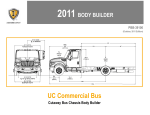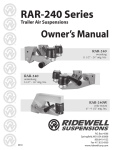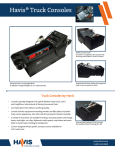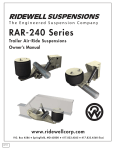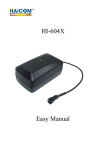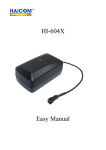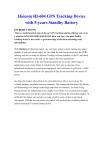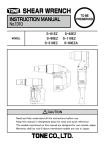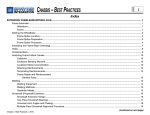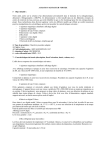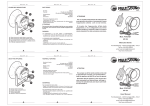Download FRAMES - Navistar
Transcript
FRAMES GENERAL FRAME INFORMATION All Models Introduction The frame is the structure that carries and supports the rated load under anticipated driving conditions and secures the major components of a vehicle in their relative positions. The frame assembly consists of two sidemembers and depending upon the length of the frame, five or more crossmembers.u01 General Frame Recommendations It is very important that the frame be inspected periodically for cracks, buckling, crossmember loosening or other damage that may cause eventual failure of the frame. Additional inspections should be made whenever the chassis has been overloaded or involved in an accident. An alignment check IS NOT SUFFICIENT since local cracks, crossmember loosening or sidemember buckling will not necessarily cause misalignment. On reinforced sidemember sections, when cracks exist in either of the sidemember sections, the members must be separated for repair. After separation follow the procedures for non-reinforced sections. The two sidemember sections MUST NOT be welded together. After the weld repairs, the sections should be reinforced with the appropriate section and re-assembled with mounting bolts tightened to SAE Grade 8 torque levels. Drilling or Notching Sidemembers should not be drilled or notched without approval from Navistar Engineering. Do not exceed the maximum allowable sidemember hole size in the unrestricted zones. For illustrations, see the Frame Drilling Restrictions later in this book. Welding or Flame Cutting Welding or flame cutting of the frame components is unacceptable because of the associated loss of fatigue strength. This restriction applies not only to the heat-treated components, but also the high strength low alloy (HSLA) and low carbon steel components. DURASTAR® SERIES BODY BUILDER FRAMES GENERAL FRAME INFORMATION - ALL MODELS FEBRUARY 2015 — PAGE 83 DURASTAR® SERIES BODY BUILDER FRAMES FEBRUARY 2015 — PAGE 84 GENERAL FRAME INFORMATION - ALL MODELS Exceptions to this are cases with Navistar Engineering approval or for repair operations as described in this service manual section. TO AVOID SERIOUS PERSONAL INJURY, DEATH OR POSSIBLE ENGINE DAMAGE, WHEN WELDING OR USING AN ACETYLENE TORCH ALWAYS WEAR WELDING GOGGLES AND GLOVES. INSURE THAT ACETYLENE AND OXYGEN TANKS ARE SEPARATED BY A METAL SHIELD AND ARE CHAINED TO A CART. DO NOT WELD OR HEAT AREAS NEAR FUEL TANKS OR FUEL LINES. UTILIZE PROPER SHIELDING AROUND HYDRAULIC LINES. Reinforcement to Increase Capacity Reinforcement of the chassis frame to support either additional loading or concentrated loading does not increase vehicle load carrying capacity unless it has been fully verified that all other vehicle components, such as the brake system, steering system, suspension system, etc. can properly and safely support the increased loading. Increase in Local Stress In any modification of the chassis frame, the addition of holes, reinforcements, welds, clamps, splices, etc., may cause an increase in the local stress in the frame at the point of the modification, THEREFORE CAUSING A STRESS CONCENTRATION IN THE FRAME SIDEMEMBER(S). These local stress concentrations can significantly affect the life of the chassis frame. The specific effect which the stress concentrator will have on the life of the chassis frame is influenced by the location of the stress concentration, the frequency and severity of the loading, and the magnitude of stress concentration. Deviation from the repair procedures in this section may void manufacturer's warranty. Identification of Frame Rail Material International® chassis are manufactured with frame rails of different alloy steels and some are heat-treated. Each material must be handled in a specific manner to assure maximum service life; therefore, the frame material must be determined before attempting repair or modification. International chassis are presently manufactured with frame rails of: • High strength low alloy (HSLA) steel (50,000, 60,000 and 80,000 PSI yield strength) • Heat treated steel (110,000 and 120,000 psi yield strength). Each type has different repair procedures. The frame rail material can be determined by inspecting the frame and consulting the dealer vehicle lineset ticket and the sales data book. Heat-treated rails are marked on the inside of the section with a decal which cautions against welding, flame cutting or the addition of holes in critical zones. These practices are restricted for all frame rails, however, HEAT-TREATED rails are much more sensitive to these alterations. Frame Damage The major sources of frame damage are accidents, overloading the vehicle, and local overstressing due to a variety of causes. In accident cases, the reasons for the damage are readily apparent. Such damage may often be repaired by: • Straightening and reinforcing the frame. • Repairing the damaged area and reinforcing the frame sidemember. • Replacing the frame sidemembers and crossmembers. Damage to the chassis frame, such as a crack in the frame sidemember or crossmember, which is not associated with impact damage, may be an indication of overloading the vehicle. Damage to the chassis frame may also be an indication of the creation of locally high stresses due to operating conditions or equipment mounting practices. Examples of overloading are: 1. Exceeding either the gross vehicle weight rating (GVWR) or the gross axle weight rating (GAWR) (loading the frame beyond its design capacity). 2. Uneven load distribution. 3. Improper fifth wheel settings. 4. Using the vehicle in operating conditions or with equipment it was not designed for. Examples of creation of locally high stresses are: 1. Mounting bodies or equipment in a manner that causes stress concentrations and/or abrasive wear in either the flange or web portion of the sidemember. 2. Improper modification or repair of frame components. 3. Equipment which is susceptible to resonant vibration due to excess flexibility of its mounting. Frame damage may also be caused by corrosion resulting from the contact between dissimilar metals. Damage to the chassis frame, which is not associated with impact damage, should not be repaired until the cause of the damage has been determined and corrective actions taken to prevent re-occurrence of the non-impact damage. DURASTAR® SERIES BODY BUILDER FRAMES GENERAL FRAME INFORMATION - ALL MODELS FEBRUARY 2015 — PAGE 85 DURASTAR® SERIES BODY BUILDER FRAMES FEBRUARY 2015 — PAGE 86 GENERAL FRAME INFORMATION - ALL MODELS Welding and Reinforcement The guidelines below deal with the general procedures for weld repair and reinforcement. Because of the many variables associated with these repairs, it is recommended that your field service representative be consulted prior to undertaking the repair. This will also help to determine whether a specific set of recommendations has already been developed for the case in question. The essential elements of repairing the sidemembers are the restoring of BOTH the shape and local strength so that the load capacity is at least as good as before the damage occurred. The sidemembers may look like new, but may have local strength reduction due to small cracks or material strength reduction. Even if the frame has acceptable alignment and there is no gross deformation, local deformations may reduce the strength in the area to be weld repaired. Examples of this are local bulges in the web (vertical portion) of the section and buckling of the flanges. These local deformations must be repaired by straightening before proceeding with the weld repair. Welding Precautions When welding on any vehicle, care must be taken to prevent damage to the electronic components. Vehicles with ELECTRONIC ENGINE CONTROL SYSTEMS require additional precautions. CAUTION: On any vehicle, disconnect both the positive and negative battery cables from the battery before welding on the vehicle. Attach the welder ground cable as close as possible to the part being welded. TO AVOID SERIOUS PERSONAL INJURY, DEATH OR POSSIBLE ENGINE DAMAGE, WHEN WELDING OR USING AN ACETYLENE TORCH ALWAYS WEAR WELDING GOGGLES AND GLOVES. INSURE THAT ACETYLENE AND OXYGEN TANKS ARE SEPARATED BY A METAL SHIELD AND ARE CHAINED TO A CART. DO NOT WELD OR HEAT AREAS NEAR FUEL TANKS OR FUEL LINES. UTILIZE PROPER SHIELDING AROUND HYDRAULIC LINES. With an electronic engine controller (such as Celect), do not connect the ground cable to the control module(s) or the cooling plate. To protect the control module(s), it is mandatory to remove all connectors going to the control modules. The following is a general guideline for the steel frames: Welding of the HSLA (50,000, 60,000 and 80,000 PSI yield strength) steel side member and the heat-treated (110,000 and 120,000 PSI yield strength) steel sidemember involves a significant reduction in the strength of the frame in the heat affected zones of the weldment. This means that the frame in the welded region is no longer capable of carrying the same load or stress as the original section. To restore the strength of the frame rails after welding, the welded area must be reinforced using reinforcements as indicated in “Repair and Reinforcement Recommended Procedures”. Welding must be done properly to make an effective repair. Therefore, only those who are properly trained and qualified should perform the welding repairs in this section. Reinforcement Reinforcements (Figure 2.1 ) to increase load capacity are generally “full length”. The actual length of the reinforcement varies with the model. Shorter, (approximately 7') rear suspension tandem liner reinforcements are available for some tractor models. Inverted “L” and “C” channel reinforcements are available for most models. For models which do not have reinforcements necessary to contact Sales Engineering to obtain reinforcement recommendations. STANDARD SIDEMEMBER SECTION HEAVY DUTY SIDEMEMBER SECTION L-REINFORCEMENT SIDEMEMBER SECTION C-REINFORCEMENT SIDEMEMBER SECTION 01_0011 Figure 2.1 Frame Rails and Reinforcements (Typical) These reinforcements are generally installed on the outside of the sidemember, although certain models require “C” channel reinforcements installed to the inside of the sidemember. Contact your International® Truck dealer regarding the required type of reinforcement. Depending on model application, there will be other parts affected, such as spring brackets for example, which are bolted to the flange as well as the web of the sidemember. To maintain proper alignment of the springs, these brackets may require replacement with new brackets designed to accept the reinforcements. These brackets are available through your International Truck dealer parts department. NOTE:When an inside reinforcement is added, the lengths of the crossmembers will be affected. DURASTAR® SERIES BODY BUILDER FRAMES GENERAL FRAME INFORMATION - ALL MODELS FEBRUARY 2015 — PAGE 87 DURASTAR® SERIES BODY BUILDER FRAMES FEBRUARY 2015 — PAGE 88 GENERAL FRAME INFORMATION - ALL MODELS Reinforcement Attachment THE REINFORCEMENTS MUST NEVER BE WELDED TO THE ORIGINAL CHASSIS SIDEMEMBERS. High strength SAE Grade 8 bolts are to be used to fasten the reinforcement to the sidemember. Existing bolt holes in the sidemembers should be used whenever possible. NOTE:The reinforcements should be bolted to the chassis frame using high strength SAE Grade 8 bolts not less than 0.5 inch (13 mm) in diameter (refer to “Bolt and Torque Information”). Corrosion If aluminum and steel are allowed to come into direct contact with each other, a galvanic cell can be formed. In order for the cell to form, the dissimilar metals must be in direct contact and an electrolyte, such as moisture, must be present. Aluminum is anodic with respect to steel and will corrode when in the presence of steel. Corrosion of aluminum frame crossmembers will reduce the load carrying capacity of the frame member and may eventually lead to the failure of the frame. To prevent the formation of a galvanic cell, isolation techniques such as non-conductive or barrier type spacers or sealers must be used so that the steel and aluminum are not in direct contact. It is recommended that a sealer, such as Tectyl 400C or equivalent, be painted onto the surface of both the aluminum and steel, as well as on the washers under the head of the bolts and nuts. Frame Alignment The frame must be properly aligned as this affects body, axle and suspension mounting. If the vehicle has been involved in an accident or has been overloaded, it is recommended that the frame be checked for proper alignment. Pre-Alignment Inspection Before checking alignment, park vehicle on level ground and set parking brake. Inspect frame assembly for loose parts, welds, cracks and bends. Be sure to make all necessary repairs before attempting to check frame alignment. Method of Checking Frame Alignment A satisfactory method of checking the frame and axle alignment, particularly when a body and cab is on a chassis, is to: 1. Place a plumb bob against the point of measurement. All measurements must be taken with the plumb bob positioned against bare metal. 2. Tack or tape pieces of paper to the floor directly under each point of measurement on the chassis as indicated by the letter “K” in Figure 2.2. 01_0012 Figure 2.2 Centerline of Chassis Method of Checking After each measurement point has been carefully marked on the floor, proceed as follows: 1. Locate centerline of chassis by measuring front and rear end widths, using marks on floor. If frame widths are within specification, draw centerline on floor, the full length of the chassis and continue with step 2. If frame widths are out of specification, lay out centerline as follows: DURASTAR® SERIES BODY BUILDER FRAMES GENERAL FRAME INFORMATION - ALL MODELS FEBRUARY 2015 — PAGE 89 DURASTAR® SERIES BODY BUILDER FRAMES FEBRUARY 2015 — PAGE 90 GENERAL FRAME INFORMATION - ALL MODELS Centerline can be drawn through the intersection of any one pair of equal diagonals (A-A, B-B, C-C, D-D) and center point of one end of frame or through points of intersection of any two pairs of equal diagonals. 2. Measure distance from centerline to opposite points marked over entire length of frame. Measurements should not vary more than 0.12 inch (3.0 mm) at any point. 3. Measuring diagonals (A-A, B-B, C-C, D-D) will indicate point where misalignment occurs. If diagonals in each pair are within 0.12 inch (3.0 mm), that part of the frame included between points of measurement may be considered in satisfactory alignment. These diagonals should intersect within 0.12 inch (3.0 mm) of the centerline. If the diagonals are not within specification, try loosening and re-tightening all cross-members. Then re-check alignment. Refer to the “Bolt Torque Chart (Phosphate and Oil Coated)”. If frame is still out of alignment, the vehicle must be taken to a suitable frame alignment establishment to confirm frame misalignment. If misalignment is confirmed, suitable measures must be taken to repair the damage. SIDE ELEVATION DIMENSIONS Dimensions for side elevation of the frame should be checked at the points indicated and should not vary more than 0.12 inch (3.0 mm) from side to side. (They will differ fore and aft due to typical frame rake.) Axle Alignment With Frame After determining that the frame is properly aligned, the axle alignment with the frame should be checked by comparing diagonals. If necessary, adjust axle-to-frame alignment. Frame Straightening NOTE: Frame straightening should only be performed by a qualified frame alignment facility. Under no circumstance should frame alignment be performed by inexperienced or unqualified service personnel. DO NOT USE HEAT TO STRAIGHTEN. Use of heat is not recommended when straightening heat-treated frame sidemembers. Heat will weaken these frame members, consequently, all straightening should be done at room temperature. Add reinforcement per section if heat straightening is done. Frame members which are bent or buckled sufficiently to show cracks or weakness after straightening should be replaced or reinforced. HEATTREATED FRAME MEMBERS MUST NOT BE INTERMIXED WITH NON-HEAT-TREATED MEMBERS. If one sidemember is to be replaced, the new member must match the former frame member in both cross-section and material strength. Repair and Reinforcement Recommended Procedures In some cases of frame damage, the sidemembers must be replaced rather than repaired. Examples of this are: 1. When sidemember cracks caused complete separation or a visible deformation of the section. 2. When the sidemembers are extensively deformed. Consult with your field service representative and frame repair specialists if in doubt. Preparation of Frame for Repair Bevel Crack to Weld To assure complete weld penetration, bevel the crack from one side when welding from one side. Bevel the crack from both sides when welding from both sides. The existing crack in the sidemember must be entirely removed (Figure 2.3). Widen the crack its full length to 1/8 inch (3 mm). If required, a rubber backed disc grinder or high speed steel burr may be used. Clean Surface to Weld Surfaces to be welded and surfaces adjacent to the weld must be free of loose scale, slag, rust, grease, moisture, paint or other material that could contribute to poor quality welds. 1. FRAME RAIL 2. WIDEN CRACK 3. BEVEL EDGES Figure 2.3 Preparing For Weld Repair DURASTAR® SERIES BODY BUILDER 01_0013 FRAMES GENERAL FRAME INFORMATION - ALL MODELS FEBRUARY 2015 — PAGE 91 DURASTAR® SERIES BODY BUILDER FRAMES FEBRUARY 2015 — PAGE 92 GENERAL FRAME INFORMATION - ALL MODELS Welding Electric arc-welding is recommended for repair of steel frames. The shielded arc method should be used because the heat generated during welding is localized and burning of material is minimized using this method. Additional advantages are that the finished weld can be ground flush and drilled as necessary. Shielded metal arc welding (SMAW); gas metal arc welding (GMAW), also known as metal inert gas (MIG) welding; gas tungsten arc welding (GTAW), also known as tungsten inert gas (TIG) welding; or flux cored arc welding (FCAW) are recommended methods for repair of steel frame members. TO AVOID SERIOUS PERSONAL INJURY, DEATH OR POSSIBLE ENGINE DAMAGE, WHEN WELDING OR USING AN ACETYLENE TORCH ALWAYS WEAR WELDING GOGGLES AND GLOVES. INSURE THAT ACETYLENE AND OXYGEN TANKS ARE SEPARATED BY A METAL SHIELD AND ARE CHAINED TO A CART. DO NOT WELD OR HEAT AREAS NEAR FUEL TANKS OR FUEL LINES. UTILIZE PROPER SHIELDING AROUND HYDRAULIC LINES. General Recommendations IMPORTANT: To properly perform the repair procedure, the following rules must be observed: All Steel Sidemembers 1. Welding should not be performed when surfaces are wet or exposed to rain, snow, high wind or when repair personnel are exposed to inclement conditions. Frames exposed to inclement weather must be thoroughly cleaned and dried before the repair is made. 2. Surface areas and edges to be joined must be clean and free of oil, grease, loose scale, rust, moisture, paint or other material that could contribute to poor quality welds. 3. Always avoid craters, notching and undercutting. 4. Peen new welds prior to grinding to relieve stresses caused by shrinkage. 5. Grind all welds flush with the surrounding surfaces. Use a coarse grinder followed by smooth grind at 90° to the crack direction to remove all of the coarse grind marks. 6. Inspect the weld repaired area carefully after grinding. Grind out any remaining cracks, notches or undercuts and repeat the finishing and inspections. 7. For welding cracks to the edge of the sidemember flange, locate a run-off block at the edge as in to obtain a continuous weld without undercuts. After welding, the run-off block should be cut off and the weld should be ground and inspected as in steps 5 and 6 above. 8. Weld to the edges of the holes: The weld should continue into the hole to form a plug weld with a copper chill block on the opposite side to help form the plug. The weld should then be finished as in steps 5 and 6 above and redrilled. Chamfer the hole edges. If the hole was open and unused, install a Grade 8 bolt to help attach the weld repair reinforcement. INVISIBLE ULTRAVIOLET AND INFRARED RAYS EMITTED IN WELDING CAN INJURE UNPROTECTED EYES AND SKIN. PROTECTION SUCH AS WELDER'S HELMET WITH DARK COLORED FILTER LENSES OF THE PROPER DENSITY MUST BE USED. GTAW OR TIG WELDING WILL PRODUCE INTENSE RADIATION, THEREFORE, FILTER PLATE LENSES OF THE DEEPEST SHADE PROVIDING ADEQUATE VISIBILITY ARE RECOMMENDED. IT IS STRONGLY RECOMMENDED THAT PERSONS WORKING IN THE WELD AREA WEAR FLASH SAFETY GOGGLES. ALSO WEAR PROTECTIVE CLOTHING. 9. Electrodes: Only low hydrogen electrodes should be used. These should be purchased in hermetically sealed containers or dried for two hours at a temperature between 450° F (232° C) and 500° F (260° C). After drying, the electrodes should be stored in an oven at a temperature of at least 250° F (121° C). If exposed to the atmosphere for more than four (4) hours, the electrodes should be dried before use. ANY MOISTURE INTRODUCED INTO THE WELD COULD DEVELOP POROSITY OR EMBRITTLEMENT, LEADING TO FURTHER CRACKING. Welding procedures will vary among different frame materials. Outlined below are recommendations for welding of the various types of frames. 1. Preheat the frame member along the prepared weld joint to 500 to 600° F (260 to 316° C). Insure the area is clean and any moisture present is eliminated. 2. Permit heated area to cool to 200° F (93° C) or below before welding is started. The weld repair area must be clean before welding. 3. Either alternating current or direct current reversed polarity, combined with a short arc and beading or narrow weave technique, may be used. Direct current reversed polarity is recommended. 4. Slag should be removed after each pass and an interpass temperature of 200° F (93° C) should be maintained. 5. Grind smooth and flush with surrounding sidemember material. Grind the weld in a direction that is 90° to crack direction (Figure 2.4 D). 6. Add reinforcement. DURASTAR® SERIES BODY BUILDER FRAMES GENERAL FRAME INFORMATION - ALL MODELS FEBRUARY 2015 — PAGE 93 DURASTAR® SERIES BODY BUILDER FRAMES FEBRUARY 2015 — PAGE 94 GENERAL FRAME INFORMATION - ALL MODELS 1. 2. 3. 4. 5. 6. Figure 2.4 Use of Chill Strip V-GROOVE INTO SOUND METAL COPPER CHILL STRIP FRAME RAIL V-GROOVE CRACK WELD-GROUND FLUSH WITH FRAME, GRIND IN LONGITUDINAL DIRECTION OF SIDEMEMBER 01_0014 High Strength Low Alloy Steel Frames (50,000, 60,000 and 80,000 PSI Yield Strength) Any of the electric arc methods previously described may be used. The choice of a suitable electrode or wire depends somewhat upon the equipment available for welding and the method selected. The SMAW and the GMAW methods are preferred for welding the HSLA frames. The use of low hydrogen electrodes is recommended. Refer to Table 2.1 for selection of recommended electrodes and wires, or refer to A.W.S. A.5 standard available from www.aws.org for equivalent strength electrodes, wires or rods and power leads to be used in the welding methods. The double V-notch weld preparation using the weld procedure shown in Figure 2.4 is the preferred welding method. Table 2.1 Recommended Electrodes and Wires RECOMMENDED ELECTRODE AND WIRE MATERIAL STRENGTH PSI SMAW GMAW 50,000 E7018 E70S-3 60,000 – E70S-1B 80,000 E8018 E80S-D2 Amperage and voltage recommendations for welding are shown in Table 2.2 and Table 2.3 Table 2.2 SMAW Method (HSLA Frames) POSITION ELECTRODE SIZES INCH WELDING CURRENT AMPERES VOLTS SPEED (INCH/MIN.) Flat .125 – – – Horizontal and Vertical .125 110/140 20/14 24 Table 2.3 GMAW Method (HSLA Frames) POSITION ELECTRODE SIZES INCH WELDING CURRENT AMPERES VOLTS SPEED (INCH/MIN.) Flat .035 – – 350/400 Horizontal and Vertical .035 190/220 20/30 350/400 7. Preheat frame rail along the weld joint to 500 to 600° F (260 to 316° C) to insure any moisture present is eliminated and to prevent too rapid cooling of weld metal. 8. Direct current, reversed polarity is preferred. Weld using a short arc and a beading or narrow weave technique. 9. Slag should be removed after each pass and an interpass temperature of 200° F (93° C) should be maintained. 10. Grind smooth and flush with surrounding sidemember material. Grind the weld in a direction that is at 90° to crack direction (Figure 2.4 D). 11. Add reinforcement. DURASTAR® SERIES BODY BUILDER FRAMES GENERAL FRAME INFORMATION - ALL MODELS FEBRUARY 2015 — PAGE 95 DURASTAR® SERIES BODY BUILDER FRAMES FEBRUARY 2015 — PAGE 96 GENERAL FRAME INFORMATION - ALL MODELS Heat Treated Frames (110,000 and 120,000 PSI Yield Strength) When welding Heat Treated Frames (110,000 PSI and 120,000 Yield Strength), use low hydrogen electrodes which have superior crack resistance and notch toughness similar to AWS-E-11018. This type electrode should be stored in a moisture-free container to avoid porosity during welding. Amperage and voltage recommendations for welding are shown in Table 2.4. Table 2.4 SMAW Method (Heat-treated Frames) POSITION AMPERES VOLTAGE Downhand 130/140 21/23 Overhead 130/140 21/23 Vertical Up 110/120 22/24 A heavy copper “chill” strip should be clamped to the rail side away from the groove to help control the temperature and cooling rate during welding (Figure 2.4). Short lengths of discarded heavy copper electrical bus bars make suitable chill strips. Preheat the frame rail along the crack area to 500-600° F (260-316° C). Either alternating current or direct current reversed polarity, combined with a short arc and a beading or narrow weave technique may be used. Direct current reversed polarity is recommended. Slag should be removed after each pass and an interpass temperature of 200° F (93° C) should be maintained. Grind smooth and flush with surrounding sidemember material, in a direction that is parallel to the longitudinal axis of the sidemember (Figure 2.4 D). A V-groove is ground from the side opposite the repair and the procedure outlined above repeated. “Chill” strips should be used whenever possible. The V-groove ground on the opposite side of the repair should be deep enough to enter the sound metal of the first weld repair as shown in Figure 2.4 C. Reinforcement The strength of the sidemember in the weld joint repair region has been reduced by welding and this region must be reinforced sufficiently to insure that the service life of the frame is not shortened. Reinforcement of the frame after welding is intended to reduce the stresses in the weld repair region to a lower level than was previously permitted. Improper drilling will also reduce the strength of the sidemembers. Refer to “Drilling or Notching”. THE TYPE, LENGTH, MATERIAL AND ATTACHMENT TECHNIQUES FOR REINFORCEMENTS VARY WITH THE TYPE AND LOCATION OF THE CRACK AND WITH THE LOADING CONDITIONS ASSOCIATED WITH THE CRACK. It is not practical to give specific recommendations for all cases of frame cracking, therefore the various types of reinforcements are identified with general descriptions of their applications and installation procedures. To aid in making the distinctions between the more critical flange area and the less critical web area, critical zones are defined as shown (Figure 2.5 D). SEE FRAME DRILLING DIAGRAMS IN SPECIFIC MODEL BOOKS FOR MINIMAL VA VALUE LUE FOR A AND B SEE FRAME DRILLING DIAGRAMS IN SPECIFIC MODEL BOOKS FOR MINIMAL VA VALUE LUE FOR A AND B 01_0015 Figure 2.5 Reinforcement Application DURASTAR® SERIES BODY BUILDER FRAMES GENERAL FRAME INFORMATION - ALL MODELS FEBRUARY 2015 — PAGE 97 DURASTAR® SERIES BODY BUILDER FRAMES FEBRUARY 2015 — PAGE 98 GENERAL FRAME INFORMATION - ALL MODELS Cracks which occur in the critical zones have a greater probability of growing vertically through the section, and the reduced strength after weld repair necessitates a more substantial reinforcement. These guidelines potentially affect the structural integrity of the frame assembly and are intended for those who have the equipment and experience required to qualify as frame repair specialists. General Weld Repair Reinforcement Procedures 1. The thickness and material strength of the local plate, “L” and channel reinforcements should match the section being reinforced. 2. The corners of the reinforcements which will be in contact with the sidemember along the reinforcement edges must be chamfered to prevent damage to the sidemember. 3. All sidemember reinforcements must be bolted to the web section within the zone shown in the frame drilling guidelines in the specific model body builder book. The bolts must be of SAE Grade 8 or better, with integral flanges or with hardened flat washers and must be tightened to Grade 8 levels. 4. Crossmember modification or replacement may be required if the reinforcement is on the same side as the crossmember. 5. Consider the potential effects of the reinforcements on the various components mounted to the frame. Check clearances for suspension, wiring, plumbing and other controls. 6. For attachment of reinforcements, use existing bolts wherever this is practical. 7. The weld repaired area of the sidemember and all of the reinforcement should be primed and painted before reinforcement installation. For corrosive environments, additional treatment of the interface may be needed. Full Length Channel Weld Repair Reinforcements “Full length” channel reinforcements are available through International® dealers for most models. The actual length, starting location and ending location vary from model to model. Different length reinforcements may also be available. When applied as a repair reinforcement, these reinforcements DO NOT increase the load capacity of the vehicle. Their advantage in this case is their availability. A disadvantage of this type is that it is likely to affect more of the components which mount to the frame. In some cases this disadvantage may be offset by cutting the full length reinforcement to create a local reinforcement. Recommended Applications 1. Cases of repair of vertical cracks in either the top or bottom flanges at very low mileage. 2. Cases in which the weld repair is accompanied by extensive straightening of heat treated sidemembers. Full Length “L” Weld Repair Reinforcements Steps 1 and 2 above also apply to the full length “L” reinforcements available from International. All of these are the inverted “L” type and are designed for installation on the outside of the sidemember section (except 9000 Series) (Figure 2.5 A). Recommended Applications This type of reinforcement is recommended for cases of cracking at very low mileage where a web crack has extended beyond the range for a flat plate reinforcement but ends short of the bend radius. It is also applicable to cases in which the cracking is accompanied by flange buckling. Application Procedures 1. For custom-fabricated full length “L” reinforcements, the section should be oriented up or down so that the flange is on the same side as the damaged area. 2. For maximum strength the flange should be on the outside of the section. 3. Follow the general recommendations above for attachment of the reinforcement. Local Channel Weld Repair Reinforcements This type of reinforcement must be custom-fabricated either by cutting lengths from “full length” reinforcements or by forming from flat stock (Figure 2.5 B). Recommended Applications 1. Cases in which the weld repair extends into the sidemember flange after substantial service life. 2. Cases accompanied by extensive abrasive wear of the sidemember section. In these cases the length of the wear area should be added to the length recommendations below. Application Procedures 1. The channel should be installed on the outside of the section for greater strength. 2. Figure 2.5 B gives recommended dimensional data and attachment specifications for a typical installation. Holes drilled for the attachment must be within the frame drilling guidelines in the specific model body builder book. DURASTAR® SERIES BODY BUILDER FRAMES GENERAL FRAME INFORMATION - ALL MODELS FEBRUARY 2015 — PAGE 99 DURASTAR® SERIES BODY BUILDER FRAMES FEBRUARY 2015 — PAGE 100 GENERAL FRAME INFORMATION - ALL MODELS Local “L” or Inverted “L” Weld Repair Reinforcements This type of reinforcement is also generally custom-fabricated. It has a greater tendency to loosen than a channel reinforcement because, for vertical deflections of the frame assembly, it tends to bend about an axis different from that of the main sidemember section. Because of this its length and/or attachment specifications are typically greater than for the channel type. Recommended Applications This type of reinforcement is recommended for cases in which the weld repair is confined to the web of the section but extends beyond the application zone of the flat plate reinforcements shown in Figure 2.5 D. Application Procedures 1. Figure 2.5 A shows a typical installation for an “L” reinforcement on the inside of a sidemember section along with minimum recommended dimensions. 2. The flange of the reinforcement should be oriented up or down so that flange is on the same side as the damaged area. 3. For maximum strength the reinforcement should be installed on the outside of the sidemember section. Flat Plate Weld Repair Reinforcements This reinforcement is intended for the less critical, web portion of the sidemember section where typical cracking is due to local stresses which tend to “diaphragm” or “dish” the web without creating appreciable stresses for overall bending of the section. Typical crack patterns radiate out from the edge of a mounting bracket or crossmember or from a hole in the web. Cracks which radiate from a web hole occupied by a fastener are frequently an indication of a defective joint, whether by the loosening of the fastener or poor joint design (Figure 2.5 C). Recommended Applications The flat plate reinforcements are recommended for weld repairs in which the weld does not extend beyond the zone defined in Figure 2.5 D. Application Procedures 1. A typical installation is shown in Figure 2.5 C. The length and height of the plate will vary with the size of the weld repair area. In general it should be such that it will accommodate an array of reinforcement attachment bolts at a typical 3 to 5 inch (76 to 127 mm) spacing all around the weld repair area. 2. The plate should generally be installed on the side opposite the component which transferred the local bending load into the web. 3. The edges of the plate should be staggered with respect to the edges of other relatively stiff web mounted components to avoid the creation of stress concentrations. Bolt and Torque Information Most frames are assembled with bolts and nuts. Others are riveted. BOLTS MUST ALWAYS BE USED WHEN ATTACHING A REINFORCEMENT. Rivets should be replaced by bolts as required when the frame is repaired and reinforced. In bolted joints, the majority of the load is transferred by frictional force or clamping force between the members of the joint. The bolts must be properly tightened to develop and maintain the desired clamping force. Operation of the joint with loose or improperly tightened bolts can lead to failure of the joint. The bolts and nuts should be inspected periodically to insure that proper torque is maintained. Bolts of high strength material conforming to SAE Grade 8 bolts should be used on all frames. For installation of reinforcements, 0.5 inch (13 mm) diameter flange head bolts are recommended. The SAE Grade 8 bolt is identified by six radial line markings on the head of the bolt (Figure 2.6). Nuts must be Grade 8 flange type. 1. 2. SAE GRADE 5 BOLTS ARE IDENTIFIED BY 3 RADIAL LINES SAE GRADE 8 BOLTS ARE IDENTIFIED BY 6 RADIAL LINES Figure 2.6 Bolt Identification 01_0016 These bolts, 0.5 inch (13 mm) diameter flange head type, should be tightened to 110 to 120 ft-lbs. (149 to 163 Nm) based on new bolts and nuts lubricated with engine oil. Whenever possible, hold the bolt and tighten the nut. If frame components are aluminum, flange head bolts and nuts, or bolts with hardened flat washers must be used. If modification or repair requires replacement of existing bolts with new bolts or bolts of a greater length, the old flange head nuts should not be used with new standard bolts. Careful consideration is given to the number, location and sizes of frame bolt holes in the design of a vehicle. The number, location and sizes of additional bolt holes put in the frame subsequent to manufacture of the vehicle can adversely affect frame strength. The adverse effect of additional bolt holes can be minimized by following the guidelines. DURASTAR® SERIES BODY BUILDER FRAMES GENERAL FRAME INFORMATION - ALL MODELS FEBRUARY 2015 — PAGE 101 DURASTAR® SERIES BODY BUILDER FRAMES FEBRUARY 2015 — PAGE 102 GENERAL FRAME INFORMATION - ALL MODELS Huckbolt Fasteners (HP 8) Huckbolt HP 8 fasteners are used in various positions in frame rail construction. Advantages to this style fastener are consistent clamp load and a high resistance to loosening due to vibration. The need to recheck fastener torque is eliminated. Figure 2.7 Huckbolt Fasteners 01_0017 Removal The swaged collar cannot be unscrewed due to the locking grooves on the HP 8 fastener. Removal requires a Huck Collar Cutter or the collar can be split with an air chisel while supporting the opposite side of the collar. When the collar is split, the fastener can be driven out with a punch. Figure 2.8 Collar Can Be Split With an Air Chisel 01_0018 CAUTION: The HP 8 fastener is not intended for re-use. To do so can result in damage to the vehicle frame or components attached to the frame. CAUTION: In the event that Huck fasteners are removed, in order to retain the same joint integrity, it is strongly recommended that new Huck fasteners be used for attachment/reattachment of components. Installation NOTE: Huckbolt HP 8 fasteners cannot be installed without Huck installation equipment. 1. Install the HP 8 fastener into the component and frame hole. 2. Place the collar over the fastener pintail (See Figure 2.9) Figure 2.9 Place Collar Over Fastener Pintail DURASTAR® SERIES BODY BUILDER 01_0019 FRAMES GENERAL FRAME INFORMATION - ALL MODELS FEBRUARY 2015 — PAGE 103 DURASTAR® SERIES BODY BUILDER FRAMES FEBRUARY 2015 — PAGE 104 GENERAL FRAME INFORMATION - ALL MODELS 3. Place the Huck installation tool over the HP 8 fastener pintail (See Figure 2.10) 2 Figure 2.10 Place Installation Tool Over Fastener Pintail 4. 01_0020 Activate the Huck installation tool. NOTE:The Huck installation tool creates a pulling force on the fastener, seating the bolt head and closing the gap between the mating surfaces. The collar is swaged into the pintail locking grooves developing clamping force (See Figure 2.11). As pulling forces further increase, the body of the fastener separates at the breakneck (See Figure 2.12), completing installation. Figure 2.11 Clamping Force is Developed 01_0021 Figure 2.12 Body of Fastener Separates at Breakneck 01_0022 Huck-Spin Fasteners Description Huck-Spin fasteners are used in various positions in frame rail construction. The installed fastener has a collar that is cold-worked or swaged over the grooved pin Figure 2.13. Advantages to this style fastener are consistent clamp load and a high resistance to loosening due to vibration. The need to recheck fastener torque is eliminated. Figure 2.13 Huck-Spin Collar DURASTAR® SERIES BODY BUILDER 01_0023 FRAMES GENERAL FRAME INFORMATION - ALL MODELS FEBRUARY 2015 — PAGE 105 DURASTAR® SERIES BODY BUILDER FRAMES FEBRUARY 2015 — PAGE 106 GENERAL FRAME INFORMATION - ALL MODELS Remove The collar cannot be removed by twisting or hammering. The collar must be cut longitudinally to the extent of the swaged section. This can be accomplished with a small wheel grinder (Figure 2.14). Figure 2.14 Cutting Collar with Wheel Grinder Drilling on opposite sides of the collar may also be used (Figure 2.15). 01_0024 Figure 2.15 Drilling the Collar 01_0025 Another method of splitting the collar is to chisel the walls of the collar (Figure 2.16). Figure 2.16 Using a Chisel to Split the Collar DURASTAR® SERIES BODY BUILDER 01_0026 FRAMES GENERAL FRAME INFORMATION - ALL MODELS FEBRUARY 2015 — PAGE 107 DURASTAR® SERIES BODY BUILDER FRAMES FEBRUARY 2015 — PAGE 108 GENERAL FRAME INFORMATION - ALL MODELS When the collar has been opened over the length of the swaged portion on two opposite sides (Figure 2.17), the fastener can be removed. The fastener may need to be hammered to remove the collar. Figure 2.17 Collar with Reliefs for Removal 01_0027 In the event the collar doesn't come loose, use a chisel or suitable tool to peel the collar sections back (Figure 2.18). Figure 2.18 Collar Peeled Back to Assist Removal 01_0028 The fastener will come free when sufficient collar material has been pulled away (Figure 2.19). Figure 2.19 Fastener Removed 01_0029 Install The Huck-Spin is installed by spinning the collar onto the fastener. The pulling action of the Huck-Spin installation tool swages the collar into the grooves of the fastener and then automatically disengages from the fastener (Figure 2.20). Figure 2.20 Huck-Spin Installation DURASTAR® SERIES BODY BUILDER 01_0030 FRAMES GENERAL FRAME INFORMATION - ALL MODELS FEBRUARY 2015 — PAGE 109 DURASTAR® SERIES BODY BUILDER FRAMES FEBRUARY 2015 — PAGE 110 GENERAL FRAME INFORMATION - ALL MODELS Special Service Tools Hydraulic Unit – Model No. 940 Used for removal and installation of the Huck Bolt. Figure 2.21 Hydraulic Unit 01_0031 Nose Assembly Tool Figure 2.22 Nose Assembly Tool 01_0032 Table 2.5 Nose Assembly Tool DURASTAR® SERIES BODY BUILDER DESCRIPTION TOOL NUMBER For 1/2 Dia. Fastener 99-1484 For 5/8 Dia. Fastener 99-1481 FRAMES GENERAL FRAME INFORMATION - ALL MODELS FEBRUARY 2015 — PAGE 111 DURASTAR® SERIES BODY BUILDER FRAMES FEBRUARY 2015 — PAGE 112 GENERAL FRAME INFORMATION - ALL MODELS Hydraulic Installation Tool Figure 2.23 Hydraulic Installation Tool 01_0033 Table 2.6 Hydraulic Installation Tool DESCRIPTION TOOL NUMBER For 1/2 Dia. Fasteners 557 For 5/8 Dia. Fasteners 585 Collar Removal Tool Table 2.7 Collar Removal Tool DESCRIPTION TOOL NUMBER For 1/2 Dia. Fasteners 516 For 5/8 Dia. Fasteners 520 ORDER TOOLS FROM: Huck International, Inc. Phone: (800) 431-3091 P.O. Box 2270, One Corporate Drive Phone: (914) 331-7300 Kingston, NY 12401 Fax: (914) 334-7333 Aftermarket Modifications Cutting the frame behind the rear axle to shorten the frame is acceptable. Mechanical cutting or sawing is preferred to torch cutting. Whenever it is necessary to cut the frame, the sidemember should be cut at an angle of 90° to the longitudinal axis. For information on cutting of the frames to lengthen the frames or modify the wheelbase, refer to “Wheelbase Alterations”. Where mounting angles are to be welded to fifth wheel assemblies, refer to fifth wheel manufacturer's recommendations. In some cases, specialized equipment such as hoists, winches, lifts, snowplows, pusher and tag axles are added to the vehicle by distributors, installers or dealers. Unless otherwise specified by the customer at the time of assembly, the vehicle is generally equipped with a standard chassis frame and the manufacturer has not made special allowances for the special equipment which is being added. The addition or installation of this special equipment on the vehicle can significantly affect the loading of the chassis frame. In some cases, it may be necessary to reinforce the frame. Care must be exercised to insure that the gross vehicle weight rating (GVWR) and/or the gross axle weight ratings (GAWR) are not exceeded. Installation of this special equipment may involve State and Federal requirements which affect vehicle certification for noise emissions, exhaust emissions, brake requirements, lighting system requirements, etc. The specialized equipment installer is responsible for the safety and durability of their product and, in addition, is responsible to insure that the equipment and its installation comply with all applicable State and Federal Department of Transportation requirements and OSHA regulations. Addition of specialized equipment may have a significant effect on other vehicle components, such as the brake system, steering system, suspension system, etc. Simple reinforcement of the chassis frame may not be adequate to provide safe operation of the vehicle. In any modification of the chassis frame, the addition of holes, reinforcements, welds, clamps, splices, etc. may cause an increase in the local stress in the frame at the point of the modification. These local stress concentrations can significantly affect the life of the chassis frame. The specific effect which the stress concentrator will have on the life of the chassis frame is influenced by the location of the stress concentration, the frequency and severity of the loading, and the type of stress concentration. Any modification of the frame may void the manufacturer's warranty. Refer to “Welding and Reinforcement” information. DURASTAR® SERIES BODY BUILDER FRAMES GENERAL FRAME INFORMATION - ALL MODELS FEBRUARY 2015 — PAGE 113 DURASTAR® SERIES BODY BUILDER FRAMES FEBRUARY 2015 — PAGE 114 GENERAL FRAME INFORMATION - ALL MODELS 45° WELD AS SHOWN CUT AT 45° ANGLE Figure 2.24 Frames – Preparation of Joint for Welding Extension 01_0034 LENGTH OF FRAME LENGTH OF FRAME Correct Grind Direction, Correct Grind Depth Correct Grind Direction, Incorrect Grind Depth LENGTH OF FRAME LENGTH OF FRAME Incorrect Grind Direction, Correct Grind Depth Incorrect Grind Direction, Incorrect Grind Depth Figure 2.25 Cross-sectional Views Showing Correct and Incorrect Methods of Finishing the Joint 01_0035 Wheelbase Alterations Shortening or lengthening a wheelbase is an added expense for the customer. Therefore, it is often to the customer's benefit to order a chassis from the factory with the desired wheelbase rather than to alter the wheelbase of the chassis on-site. The preferred method for altering the wheelbase is to slide the rear axle forward or rearward as required. Invariably, this requires the lengthening or shortening of air lines, brake lines, electrical lines, and driveline. Extreme care should be taken in the modification of the air lines, brake lines, electrical lines and driveline to insure that they operate as reliably as those with which the vehicle was manufactured. If the wheelbase is lengthened, a reinforcement may be required. Consult your International® dealer before lengthening the wheelbase. In those instances when it is necessary to cut and weld the frame to alter the wheelbase, the frame must be reinforced with a channel-type reinforcement of the same strength as the original frame material in the area where the frame has been cut, extending at least two feet on either side of the cut and bolted as specified in Figure 2.5 D shown earlier in this section. If the frame was built with both a main frame and a reinforcement, the reinforcement should be removed before cutting the main frame. IT IS ESSENTIAL THAT A NEW ONE-PIECE OUTER CHANNEL REINFORCEMENT BE OBTAINED RATHER THAN CUTTING AND RE-USING THE ORIGINAL REINFORCEMENT. The original frame should also be reinforced with an inner channel reinforcement, extending at least two feet beyond the cut(s) on either side of the cut(s). The reinforcement must be of the same material as the original frame. Blank and pre-punched chassis channel reinforcements are available through your dealer parts department. On both medium and high strength aluminum frames, RE-WELDING TO LENGTHEN THE FRAME IS NOT RECOMMENDED. Refer to “Reinforcement” and “Reinforcement Attachment” for additional information. DURASTAR® SERIES BODY BUILDER FRAMES GENERAL FRAME INFORMATION - ALL MODELS FEBRUARY 2015 — PAGE 115 DURASTAR® SERIES BODY BUILDER FRAMES FRAME RAIL CROSS-SECTIONS - ALL MODELS FEBRUARY 2015 — PAGE 116 FRAME RAIL CROSS-SECTIONS ALL MODELS 3.062" 3.062" 3.062" 3.092" 3.892" 3.610" 3.580" .312" 10.813" .495" 9.125" 9.125" 10.125" 10.250" 10.250" 10.125" .312" 10.125" .312" .312" .375" .312" .375" .312" 3.580" 01CAB 01CAA 01_0053 01CAE / 01CEK 01CAD 01CAC 01_0055 01_0054 01CAG / 01CEL 01_0057 01_0056 01CAH / 01CEM 01CAE / 01GBP 01_0059 01_0058 01_0086 Side Rail & Reinforcement Descriptions [2] Frame Key Code Dimensions (inches) 01CAA Depth Width 9.125 3.062 Yield Strength Nominal (psi) Material # 80,000 B Section Modulus [1] (inches3) Thickness Maximum Straight Channel Side Rail – Kick-Up at Rear Suspension Rearward [3] 0.312 Resisting Bending Moment (In.-Lbs.) Nominal Maximum Design 11.47 10.74 917,600 859,200 917,600 859,200 Straight Channel Side Rail 01CAB 9.125 3.062 0.312 80,000 B 11.47 10.74 01CAC 10.125 3.062 0.312 50,000 B 13.31 12.64 665,500 632,000 01CAD 10.250 3.092 0.375 80,000 B 15.94 15.14 1,275,200 1,211,200 01CAE, 01CEK[4] 10.125 3.580 0.312 120,000 C 14.85 14.18 1,782,000 1,701,600 [4] 01CAG, 01CEL 10.250 3.610 0.375 120,000 C 17.79 16.98 2,134,800 2,037,600 01CAH, 01CEM[4] 10.375 3.705 0.438 120,000 C 21.05 20.11 2,526,000 2,413,200 01CAE 01GBP 10.125 10.813 3.580 3.892 29.84 3,806,400 3,580,800 Straight Channel Side Rail with Outer “C”Channel Reinforcement 0.312 0.312 120,000 120,000 C C 31.72 NOTES: B = High Strength Low Alloy Steel C = Heat Treated Alloy Steel [1]=Section Modulus: Nominal – Calculated using design dimensions; indicates the design load capacity of the frame Maximum Tolerance – All frame dimensions are at maximum tolerance; used by some competitors as advertised values. [2]=Reinforcement dimensions and specifications are shown in italics [3]=Rail depth given is for base rail… depth of kick-up in AF section is 6.495" [4]=33,000-lb GVWR only DURASTAR® SERIES BODY BUILDER FRAMES FRAME RAIL CROSS-SECTIONS - ALL MODELS FEBRUARY 2015 — PAGE 117 DURASTAR® SERIES BODY BUILDER FRAMES INTERMEDIATE CROSSMEMBER LOCATION - LP AND 4x2 - STANDARD CAB FEBRUARY 2015 — PAGE 118 INTERMEDIATE CROSSMEMBER LOCATION LP and 4x2 - Standard Cab Wheelbase Range Min AX Max BX [3] G CX A Inches (Millimeters) up to 138 (3500) [1] – – – 140 (3550) 156 (3950) 19 (489) – – 158 (4000) 169 (4300) 28 (713) – – 171 (4350) 183 (4650) 37 (937) – 185 (4700) 195 (4950) 43 (1161) [1] – [1] 197 (5000) 211 (5350) 213 (5400) 224 (5700) 226 (5750) 236 (6000) 238 (6050) 254 (6450) 256 (6500) 266 (6750) 268 (6800) 280 (7100) 282 (7150) 293 (7450) 295 (7500) 307 (7800) 309 (7850) 321 (8150) 323 (8200) 331 (8400) With I6 Engines 19 (489) [2] 35 28 (713) [2] (896) [2] 44 (1120) 8.2 (209) TO BACK OF CAB G H J TO CENTER LINE FRONT SPRING EYE CENTER LINE REAR AXLE AF WB 10.6 – 30.9 29.3 10.6 8.4 – – [2] KICK-UP RAIL L LP MODELS S – [1] 44 (1120) [2] 29.9 44 (1120) 62 (1568) 62 (1568) BETWEEN FRAME RAILS CX – 53 (1344) 37 (937) BX E STRAIGHT RAIL L 62 (1568) [1] 35 (896) 92.1 (2339) CENTER LINE FRONT AXLE 53 (1344) 46 (1161) [1] 25.0 (635) – 35 (896) 37 (937) AX C B 33.5 (851) F D G A B [2] With V8 Engines, 4x2 Models only C SINGLE STAMPED CROSSMEMBER MOUNTED WITH FLAT FLANGE UP AND WEB FORWARD D REAR SUSPENSION CROSSMEMBER E WITH STRAIGHT RAILS − SINGLE STAMPED CROSSMEMBER MOUNTED WITH FLAT FLANGE DOWN AND WEB FORWARD. WITH KICK-UP RAILS − C-CHANNEL AF CROSSMEMBER F 71 (1792) 28.3 G WITH STRAIGHT RAILS − SINGLE STAMPED CROSSMEMBER MOUNTED WITH FLAT FLANGE DOWN AND WEB FORWARD 01_0060 INTERMEDIATE CROSSMEMBER LOCATION 4x2 - Standard Cab with Staggered Fuel Tanks Wheelbase Range Min Max AX BX [3] CX Inches (Millimeters) up to 138 (3500) – – – 140 (3550) 169 (4300) 22 (567) – – 171 (4350) 183 (4650) 31 (791) – – – 27 (695) – – 185 (4700) 195 (4950) 40 (1015) – – 197 (5000) 211 (5350) 41 (1042) – 212 (5400) 236 (6000) 59 (1490) – 238 (6050) 254 (6450) 256 (6500) 266 (6750) 268 (6800) 280 (7100) 282 (7150) 293 (7450) 295 (7500) 307 (7800) 309 (7850) 321 (8150) 323 (8200) 331 (8400) 177 (4500)[1 ] 31 (791) 40 (1015) 67 (1714) (1266) – 44 (1120) 59 (1490) 62 (1568) 31 (791) 67 (1714) 71 (1792) [1] With 04WZA durastar_ddcrossmember DURASTAR® SERIES BODY BUILDER FRAMES FEBRUARY 2015 — PAGE 119 INTERMEDIATE CROSSMEMBER LOCATION - 4x2 - STANDARD CAB WITH STAGGERED FUEL TANKS DURASTAR® SERIES BODY BUILDER FRAMES INTERMEDIATE CROSSMEMBER LOCATION - LP AND 4x2 - EXTENDED CAB FEBRUARY 2015 — PAGE 120 INTERMEDIATE CROSSMEMBER LOCATION LP and 4x2 - Extended Cab Wheelbase Range Min Max AX BX G CX A Inches (Millimeters) up to 169 (4300) AX – – – 171 (4350) 183 (4650) 11 (277) – – 185 (4700) 195 (4950) 20 (501) [1] – – 197 (5000) 211 (5350) 213 (5400) 224 (5700) 226 (5750) 236 (6000) 238 (6050) 254 (6450) 256 (6500) 266 (6750) 268 (6800) 280 (7100) 282 (7150) 293 (7450) 295 (7500) 307 (7800) 309 (7850) 311 (7900) [1] With I6 Engines [2] With V8 Engines 29 (725) [2] 35 (896) 53 (1344) 20 (501) [1] 62 (1568) [1] [2] 44 (1120) [2] 44 (1120) 11 (277) 118.1 (3000) TO CENTER LINE FRONT SPRING EYE – CENTER LINE FRONT AXLE 11 (277) 37 (949) 25.0 (635) B C BX G H J CENTER LINE REAR AXLE AF WB 10.6 STRAIGHT RAIL – KICK-UP RAIL LP MODELS 44 (1120) 8.4 10.6 29.9 28.3 G A 53 (1344) 29.3 30.9 – 62 (1568) 20 (501) 33.5 (851) BETWEEN FRAME RAILS E 7.8 (197) TO BACK OF CAB 53 (1344) 62 (1568) F D CX B D SINGLE STAMPED CROSSMEMBER MOUNTED WITH FLAT FLANGE UP AND WEB FORWARD REAR SUSPENSION CROSSMEMBER E F C G WITH STRAIGHT RAILS − SINGLE STAMPED CROSSMEMBER MOUNTED WITH FLAT FLANGE DOWN AND WEB FORWARD. WITH KICK-UP RAILS − C-CHANNEL AF CROSSMEMBER WITH STRAIGHT RAILS − SINGLE STAMPED CROSSMEMBER MOUNTED WITH FLAT FLANGE DOWN AND WEB FORWARD 01_0061 INTERMEDIATE CROSSMEMBER LOCATION 4x2 - Extended Cab with Staggered Fuel Tanks Wheelbase Range Min Max AX BX CX Inches (Millimeters) up to 169 (4300) – – – 171 (4350) 195 (4950) – – 197 (5000) 211 (5350) 32 (818) – 213 (5400) 236 (6000) 50 (1266) – 238 (6050) 254 (6450) 67 (1714) – 256 (6500) 266 (6750) 268 (6800) 280 (7100) 282 (7150) 293 (7450) 295 (7500) 307 (7800) 59 (1490) 309 (7850) 311 (7900) 68 (1714) 14 (355) 41 (1042) 44 (1120) 50 (1266) 62 (1568 53 (1344) durastar_ddcrossmember DURASTAR® SERIES BODY BUILDER FRAMES FEBRUARY 2015 — PAGE 121 INTERMEDIATE CROSSMEMBER LOCATION - 4x2 - EXTENDED CAB WITH STAGGERED FUEL TANKS DURASTAR® SERIES BODY BUILDER FRAMES INTERMEDIATE CROSSMEMBER LOCATION - LP AND 4x2 - CREW CAB FEBRUARY 2015 — PAGE 122 INTERMEDIATE CROSSMEMBER LOCATION LP and 4x2 - Crew Cab Wheelbase Range Min Max AX G BX B up to 183 (4650) – 185 (4700) 195 (5000) 19 (494) – 197 (5050) 211 (5350) 28 (718) – 213 (5400) 224 (5700) 37 (942) – 226 (5750) 236 (6100) 55 (1390) – 238 (6150) 254 (6450) 19 (494) 266 (6750) 37 (942) 268 (6800) 280 (7100) 46 (1166) 282 (7150) 293 (7450) 295 (7500) 321 (8150) 55 (1390) 25.0 (635) 136.0 (3455) 33.5 (851) BETWEEN FRAME RAILS E BX AX – 256 (6500) D A Inches (Millimeters) F 8.0 (204) G H TO BACK OF CAB J TO CENTER LINE FRONT SPRING EYE CENTER LINE FRONT AXLE CENTER LINE REAR AXLE AF WB 10.6 44 (1120) STRAIGHT RAIL 53 (1344) KICK-UP RAIL LP MODELS 62 (1568) 30.9 29.3 10.6 8.4 29.9 28.3 G A B D REAR SUSPENSION CROSSMEMBER WITH STRAIGHT RAILS − SINGLE STAMPED CROSSMEMBER MOUNTED WITH FLAT FLANGE DOWN AND WEB FORWARD. WITH KICK-UP RAILS − C-CHANNEL AF CROSSMEMBER E F SINGLE STAMPED CROSSMEMBER MOUNTED WITH FLAT FLANGE UP AND WEB FORWARD G WITH STRAIGHT RAILS − SINGLE STAMPED CROSSMEMBER MOUNTED WITH FLAT FLANGE DOWN AND WEB FORWARD 01_0062 INTERMEDIATE CROSSMEMBER LOCATION 4x2 - Crew Cab with Staggered Fuel Tanks Wheelbase Range Min Max AX BX Inches (Millimeters) up to 183 (4650) – – 185 (4700) 195 (5000) 19 (494) – 197 (5050) 211 (5350) 28 (718) – 213 (5400) 224 (5700) 37 (942) – 226 (5750) 236 (6100) 55 (1390) – 238 (6150) 254 (6450) 19 (494) 256 (6500) 266 (6750) 37 (942) 268 (6800) 280 (7100) 46 (1166) 282 (7150) 293 (7450) 295 (7500) 321 (8150) 55 (1390) 44 (1120) 53 (1344) 62 (1568) durastar_ddcrossmember DURASTAR® SERIES BODY BUILDER FRAMES FEBRUARY 2015 — PAGE 123 INTERMEDIATE CROSSMEMBER LOCATION - 4x2 - CREW CAB WITH STAGGERED FUEL TANKS DURASTAR® SERIES BODY BUILDER FRAMES INTERMEDIATE CROSSMEMBER LOCATION - 6x4 - STANDARD CAB FEBRUARY 2015 — PAGE 124 INTERMEDIATE CROSSMEMBER LOCATION 6x4 - Standard Cab Wheelbase Range Min Max AX BX CX G C F D Inches (Millimeters) up to 158 (4000) B A AX – – – 160 (4050) 197 (5000) 19 (489) – – 199 (5050) 211 (5350) 37 (937) – – 213 (5400) 224 (5700) 46 (1161) – – 226 (5750) 238 (6050) 35 (896) – 240 (6100) 252 (6400) 254 (6450) 266 (6750) 268 (6800) 280 (7100) 282 (7150) 37 (937) + 293 (7450) 62 (1568) 26 (672) 295 (7500) 307 (7800) 35 (896) 309 (7850) 321 (8150) 323 (8200) 331 (8400) 53 (1344) 8.2 (209) TO BACK OF CAB 33.5 (851) BETWEEN FRAME RAILS 92.1 (2340) TO CENTER LINE FRONT SPRING EYE CENTER LINE FRONT AXLE – – 44 (1120) 25.0 (635) G H J – 53 (1344) 37 (937) E CX + 44 (1120) 46 (1161) BX CENTER LINE REAR SUSPENSION AF WB 11.6 (295) STRAIGHT RAIL + + 53.8 (1367) 53 (1344) A 62 (1568) B C SINGLE STAMPED CROSSMEMBER MOUNTED WITH FLAT FLANGE UP AND WEB FORWARD REAR SUSPENSION CROSSMEMBER − DOUBLE STAMPED CROSSMEMBER D E 49.2 (1249) F G STAMPED CROSSMEMBER MOUNTED WITH FLAT FLANGE UP 01_0063 INTERMEDIATE CROSSMEMBER LOCATION 6x4 - Standard Cab with Staggered Fuel Tanks Wheelbase Range Min AX BX CX Max Inches (Millimeters) up to 157 (4000) – – – 160 (4050) 197 (5000) 23 (567) – – 199 (5050) 211 (5350) 31 (791) – – 213 (5400) 224 (5700) 40 (1015) – – 226 (5750) 238 (6050) 41 (1042) – 240 (6100) 252 (6400) 254 (6450) 266 (6750) 268 (6800) 280 (7100) 282 (7150) 31 (791) 50 (1266) 40 (1015) – – 59 (1490) – 293 (7450) 67 (1714) 26 (672) 295 (7500) 307 (7800) 41 (1042) 309 (7850) 321 (8150) 323 (8200) 331 (8400) 31 (791) 50 (1266) 59 (1490) 53 (1344) 62 (1568) durastar_ddcrossmember DURASTAR® SERIES BODY BUILDER FRAMES FEBRUARY 2015 — PAGE 125 INTERMEDIATE CROSSMEMBER LOCATION - 6x4 - STANDARD CAB WITH STAGGERED FUEL TANKS DURASTAR® SERIES BODY BUILDER FRAMES INTERMEDIATE CROSSMEMBER LOCATION - 6x4 - EXTENDED CAB FEBRUARY 2015 — PAGE 126 INTERMEDIATE CROSSMEMBER LOCATION 6x4 - Extended Cab Wheelbase Range Min Max AX BX G CX A Inches (Millimeters) up to 197 (5000) – – – 199 (5050) 211 (5350) 11 (277) – – 213 (5400) 224 (5700) 20 (501) – – 226 (5750) 238 (6050) 240 (6100) 252 (6400) 254 (6450) 266 (6750) 268 (6800) 280 (7100) 282 (7150) 11 (277) 35 (896) BX E CX + + 7.8 (197) TO BACK OF CAB 25.0 (635) – 293 (7450) 62 (1568) 26 (672) 295 (7500) 307 (7800) 35 (896) 309 (7850) 321 (8150) 323 (8200) 331 (8400) 53 (1344) G H J – – 44 (1120) 33.5 (851) BETWEEN FRAME RAILS 3000 TO CENTER LINE FRONT SPRING EYE – 53 (1344) 11 (277) C 118.1 44 (1120) 20 (501) AX B F D 53 (1344) CENTER LINE REAR SUSPENSION AF CENTER LINE FRONT AXLE WB 11.6 (295) STRAIGHT RAIL + + 62 (1568) 53.8 (1367) A B C SINGLE STAMPED CROSSMEMBER MOUNTED WITH FLAT FLANGE UP AND WEB FORWARD REAR SUSPENSION CROSSMEMBER − DOUBLE STAMPED CROSSMEMBER D E 49.2 (1249) F G STAMPED CROSSMEMBER MOUNTED WITH FLAT FLANGE UP 01_0064 INTERMEDIATE CROSSMEMBER LOCATION 6x4 - Extended Cab with Staggered Fuel Tanks Wheelbase Range Min AX BX CX Max Inches (Millimeters) up to 224 (5700) – – 226 (5750) 238 (6050) 32 (818) – 240 (6100) 252 (6400) 41 (1042) – 254 (6450) 266 (6750) 50 (1266) – 268 (6800) 280 (7100) 59 (1490) – 282 (7150) 293 (7450) 67 (1714) 26 (672) 295 (7500) 307 (7800) 32 (818) 309 (7850) 321 (8150) 41 (1042) 323 (8200) 331 (8400) 50 (1266) 14 (355) 53 (1344) 62 (1568) durastar_ddcrossmember DURASTAR® SERIES BODY BUILDER FRAMES FEBRUARY 2015 — PAGE 127 INTERMEDIATE CROSSMEMBER LOCATION - 6x4 - EXTENDED CAB WITH STAGGERED FUEL TANKS DURASTAR® SERIES BODY BUILDER FRAMES INTERMEDIATE CROSSMEMBER LOCATION - 6x4 - CREW CAB FEBRUARY 2015 — PAGE 128 INTERMEDIATE CROSSMEMBER LOCATION 6x4 - Crew Cab Wheelbase Range Min Max AX G BX B up to 211 (5350) – 226 (5750) 238 (6050) 240 (6100) 252 (6400) 37 (942) 254 (6450) 266 (6750) 46 (1166) – 268 (6800) 280 (7100) 55 (1390) 26 (672) 282 (7150) 293 (7450) 295 (7500) 307 (7800) 309 (7850) 321 (8150) 37 (942) BX AX 224 (5700) 28 (718) 33.5 (851) BETWEEN FRAME RAILS E – 213 (5400) 28 (718) D A Inches (Millimeters) F – 25.0 (635) – 136.0 (3455) 8.0 (204) G H TO BACK OF CAB J TO CENTER LINE FRONT SPRING EYE – CENTER LINE FRONT AXLE CENTER LINE REAR AXLE AF WB 10.6 STRAIGHT RAIL 44 (1120) 53 (1344) KICK-UP RAIL LP MODELS 30.9 29.3 10.6 8.4 29.9 28.3 G A B D REAR SUSPENSION CROSSMEMBER WITH STRAIGHT RAILS − SINGLE STAMPED CROSSMEMBER MOUNTED WITH FLAT FLANGE DOWN AND WEB FORWARD. WITH KICK-UP RAILS − C-CHANNEL AF CROSSMEMBER E F SINGLE STAMPED CROSSMEMBER MOUNTED WITH FLAT FLANGE UP AND WEB FORWARD G WITH STRAIGHT RAILS − SINGLE STAMPED CROSSMEMBER MOUNTED WITH FLAT FLANGE DOWN AND WEB FORWARD 01_0060 INTERMEDIATE CROSSMEMBER LOCATION 6x4 - Crew Cab with Staggered Fuel Tanks Wheelbase Range Min Max AX BX Inches (Millimeters) up to 211 (5350) – – 213 (5400) 224 (5700) 226 (5750) 238 (6050) 240 (6100) 252 (6400) 37 (942) – 254 (6450) 266 (6750) 46 (1166) – 268 (6800) 280 (7100) 55 (1390) 26 (672) 282 (7150) 293 (7450) 295 (7500) 307 (7800) 309 (7850) 321 (8150) 28 (718) 28 (718) 37 (942) – – 44 (1120) 53 (1344) durastar_ddcrossmember DURASTAR® SERIES BODY BUILDER FRAMES FEBRUARY 2015 — PAGE 129 INTERMEDIATE CROSSMEMBER LOCATION - 6x4 - CREW CAB WITH STAGGERED FUEL TANKS DURASTAR® SERIES BODY BUILDER FRAMES AF CROSSMEMBER LOCATIONS - LP AND 4X2 FEBRUARY 2015 — PAGE 130 AF CROSSMEMBER LOCATIONS LP and 4x2 WITH STRAIGHT RAILS G AF Range Crossmember Min G Max H J A Inches (Millimeters) 1 85 (2150) 2 116 (2950) 3 AX – 175 (4450) 53 (1338) BX E BETWEEN FRAME RAILS CX – – 31 (800) 144 (3650) C B 33.5 (851) F D 25.0 (635) 92.1 (2339) 31 (800) CENTER LINE FRONT AXLE 8.2 (209) TO BACK OF CAB G H J TO CENTER LINE FRONT SPRING EYE CENTER LINE REAR AXLE AF WB 10.6 WITH LP RAILS Crossmember 1 STRAIGHT RAIL L AF G 30.9 29.3 10.6 8.4 Inches (Millimeters) 96 (2450) 51 (1298) KICK-UP RAIL L LP MODELS S 29.9 28.3 G A B C SINGLE STAMPED CROSSMEMBER MOUNTED WITH FLAT FLANGE UP AND WEB FORWARD D REAR SUSPENSION CROSSMEMBER E WITH STRAIGHT RAILS − SINGLE STAMPED CROSSMEMBER MOUNTED WITH FLAT FLANGE DOWN AND WEB FORWARD. WITH KICK-UP RAILS − C-CHANNEL AF CROSSMEMBER F G WITH STRAIGHT RAILS − SINGLE STAMPED CROSSMEMBER MOUNTED WITH FLAT FLANGE DOWN AND WEB FORWARD 01_0060 AF CROSSMEMBER LOCATIONS 6x4 WITH 52” SPREAD SUSPENSION Crossmember Min B A AF Range G Max H G C J F D AX BX E CX Inches (Millimeters) 1 104 (2650) 2 134 (3400) 3 + – – + 175 (4450) 72 (1838) 163 (4150) 25.0 (635) – 30 (750) 30 (750) CENTER LINE FRONT AXLE Max G H 112 (2650) 2 142 (3600) 3 171 (4350) J STRAIGHT RAIL + + – 175 (4450) H 11.6 (295) J Inches (Millimeters) 1 G CENTER LINE REAR SUSPENSION AF WB AF Range Min 33.5 (851) BETWEEN FRAME RAILS 92.1 (2340) TO CENTER LINE FRONT SPRING EYE WITH 55” AND 60” SPREAD SUSPENSION Crossmember 8.2 (209) TO BACK OF CAB 80 (2038) – – 53.8 (1367) A B C 30 (750) 30 (750) SINGLE STAMPED CROSSMEMBER MOUNTED WITH FLAT FLANGE UP AND WEB FORWARD REAR SUSPENSION CROSSMEMBER − DOUBLE STAMPED CROSSMEMBER D E 49.2 (1249) F G STAMPED CROSSMEMBER MOUNTED WITH FLAT FLANGE UP 01_0063 DURASTAR® SERIES BODY BUILDER FRAMES AF CROSSMEMBER LOCATIONS - 6X4 FEBRUARY 2015 — PAGE 131 DURASTAR® SERIES BODY BUILDER FRAMES CROSSMEMBERS - ALL MODELS FEBRUARY 2015 — PAGE 132 CROSSMEMBERS All Models 3.2 (81) 1.9 (48) 3.8 (97) 3.2 (81) + 5.8 (147) 33.5 (851) 3.0 (76) 11.6 (295) 5.8 (147) 8.4 (214) 4.8 (122) 1.9 (48) 4.6 (117) 33.5 (851) 8.1 (206) SINGLE STAMPED CROSSMEMBER DOUBLE STAMPED CROSSMEMBER 1.4 (36) 33.5 (851) 2.4 (62) 25.0 (635) 4.3 (108) 16.2 (412) 6.8 (173) 5.9 (149) 2.4 (60) .374 MATL THK (9) 4.8 (122) END FACE FLAT AREA 10.1 (257) 6.7 (170) REAR CAB MOUNTING CROSSMEMBER .9 (24) 2.4 (61) 1.7 (42) 2.4 (61) 4.8 (122) 3.8 (96) 1.9 (4.8) 7.6 (192) 01_0066 Crossmembers With Tapered Rails LP 5.0 (127) 1.2 (30) 8.4 (213) 7.4 (188) 33.5 (851) 33.5 (851) 3.2 (82) 6.8 (173) 31.5 (800) 4.6 (117) .8 (20) .7 (17) 5.3 (135) 1.3 (33) 3.0 (76) 2.2 (56) 26.7 (678) 4.8 (122) 6.0 (152) 3.0 (76) 5.4 (137) 1.2 (30) 1.2 (29) “C” CHANNEL REAR SUSPENSION CROSSMEMBER “C” CHANNEL AF CROSSMEMBER 01_0067 DURASTAR® SERIES BODY BUILDER FRAMES CROSSMEMBERS WITH TAPERED RAILS - LP FEBRUARY 2015 — PAGE 133 DURASTAR® SERIES BODY BUILDER FRAMES FRAME DRILLING GUIDELINES - ALL MODELS FEBRUARY 2015 — PAGE 134 FRAME DRILLING GUIDELINES All Models The drilling of the frame sidemember presents no unusual difficulty. Standard high speed steel drills of good quality will serve provided they are sharpened properly and not overheated during sharpening or use. Hole Location Guidelines 1. Never drill holes into the restricted areas of the frame rails. Refer to diagrams on the following pages. 2. Use existing holes whenever possible. 3. Maintain a minimum of 0.75 inch (19 mm) of material between holes. 4. There should not be more than three holes located on a vertical line. 5. Bolt holes should be no larger than is required for the size of bolts being used, in no instance larger than 11/16 (.688 inch). 6. If reinforcements are used, avoid drilling holes closer than 2.0 inches (51 mm) from the ends of the reinforcement. 7. Bolts must be periodically checked to insure that the proper torque and clamping force is maintained. 8. Never drill any holes in the flanges of the frame rail. FRAME DRILLING RESTRICTIONS 4300 4x2, 4400 4x2 and 6x4 Straight Rails/Straight Trucks 1.6 (41) 1.6 (41) 10.0 (254) 2.0 (51) NO DRILL ZONE C C CENTERLINE REAR SUSPENSION CENTERLINE OF DRILLED HOLES 2.0 (51) SECTION C − C 01_0068 DURASTAR® SERIES BODY BUILDER FRAMES FRAME DRILLING RESTRICTIONS - 4300 4X2, 4400 4X2 AND 6X4 FEBRUARY 2015 — PAGE 135 DURASTAR® SERIES BODY BUILDER FRAMES FRAME DRILLING RESTRICTIONS - LP FEBRUARY 2015 — PAGE 136 FRAME DRILLING RESTRICTIONS LP Tapered Rails 1.5 (38) NO DRILL ZONE 1.5 (38) 10.0 (254) 2.0 B (51) D D CENTERLINE REAR SUSPENSION 1.5 (38) C CENTERLINE OF DRILLED HOLES B OR C SECTION D − D 01_0069 MAXIMUM WHEELBASE FRAME STRETCHING All Models Frames – Maximum Wheelbase Figures For Changing Wheelbase Frame Code Frame Description Maximum Frame GVW Rating (Lbs) Maximum Front Axle/Susp. Capacity (Lbs) Maximum Wheelbase 01CAA 5/16" x 9 1/8" Tapered Rail 80 psi Yield Strength 29,000 8,000 254 01CAB 5/16" x 9 1/8" Straight Rail 80 psi Yield Strength 25,999 25,999 01CAC 5/16" x 10 1/8" Straight Rail 50 psi Yield Strength 29,000 32,900 32,900 01CAD 01CAE/01CEK 01CAG/01CEL 01CAH/01CEM 01CAE w/01GBP 3/8" x 10 1/4" Straight Rail 80 psi Yield Strength 5/16" x 10 1/8" Straight Rail 120 psi Yield Strength 3/8" x 10 1/4" Straight Rail 120 psi Yield Strength 7/16" x 10 3/8" Straight Rail 120 psi Yield Strength 5/16" x 10 1/8" Straight Rail with 5/16” x 10-13/16” Outer “C” Channel Reinforcement 120 psi Yield Strength 8,000 285 10,000/12,000 262 8,000 311 10,000/12,000 293 8,000 285 10,000 260 12,000 171 10,000 311 12,000 272 33,000 10,000 260 38,000 12,000 171 50,000 10,000 283 52,000 12,000 238 54,000 14,000 167 50,000 10,000 311 52,000 12,000 266 54,000 14,000 230 50,000 10,000 311 52,000 12,000 293 54,000 14,000 256 54,000 14,000 311 Contact your local International dealer for approval if your wheelbase or axle load exceeds the values given. See General Frame information – Aftermarket Modifications, earlier in this section. DURASTAR® SERIES BODY BUILDER FRAMES MAXIMUM WHEELBASE FRAME STRETCHING - ALL MODELS FEBRUARY 2015 — PAGE 137 DURASTAR® SERIES BODY BUILDER FRAMES FEBRUARY 2015 — PAGE 138 FRAME HEIGHT CALCULATION – AT CENTERLINE OF FRONT AXLE - ALL MODELS FRAME HEIGHT CALCULATION – AT CENTERLINE OF FRONT AXLE All Models The front frame height (@ the centerline of the front axle) may be calculated using the following equations. Refer to the illustration for a visual explanation of the symbols used in these calculations. Df = ′ ′ Wheel axis to bottom of frame in unladen position. Refer to tabulated data. Df′ = Wheel axis to bottom of frame in loaded position. Refer to tabulated data. F= Frame rail height. Refer to tabulated data. SLR = Static Loaded Radius. The distance from the wheel axis to the ground for a properly inflated, fully loaded (loaded to its maximum capacity) tire. To obtain tire dimensions, contact the tire manufacturer. R1 = Tire Radius (one half of tire outside diameter) NOT mounted on the vehicle. To obtain tire dimensions, contact the tire manufacturer. Calculated Tire Radius on an unloaded chassis. The value of R2 is R2 = calculated using the following method. R 2 = R 1 – .2 ( R 1 – SLR ) 01_0071 Y= Y′= Front Frame Height at the front axle centerline in unloaded condition. Front Frame Height at the front axle centerline in loaded condition. Y = Df + R2 + F Y′ = D f ′ + SLR + F NOTE: (for unloaded condition) (for loaded condition) Values calculated for Y and Y′ are strictly for the frame height at the front axle centerline. For frame heights at the front of the frame rail, refer to “FRAME HEIGHT CALCULATION – AT FRONT AND REAR RAIL ENDS”. FRAME HEIGHT DATA – FRONT All Models Front Suspension Type Parabolic * Spindle To Bottom Of Frame Capacity Code 8,000-lb 03ADA 9,000-lb 03AGW 10,000-lb 03ADB Model Unloaded – Dr Loaded – Dr′ LP 4x2 5.5" 4.5" X X 12.4” 12.2” 6.6” 5.6” X X 7.1" 5.5" X X 12.4” 11.5” 11,000-lb 03AGE 7.1” 5.5” X 12,000-lb 03ADC 7.5" 5.6" X 13,000-lb 03AGS 7.1” 5.5” X 14,000-lb 03ADD 7.4" 5.7" X 14,600-lb 03AGT 7.58” 6.1” X 6x4 Top of standard frame in model Adjust dimensions for optional frame reinforcements – See Frame Section Frame Code Frame Description Frame Rail Height (F) 01CAA 5/16" x 9 1/8" Tapered Rail – 80 psi Yield Strength 9.125" 01CAB 5/16" x 9 1/8" Straight Rail – 80 psi Yield Strength 9.125" 01CAC 5/16" x 10 1/8" Straight Rail – 50 psi Yield Strength 10.125" 01CAD 3/8" x 10 1/4" Straight Rail – 80 psi Yield Strength 10.250" 01CAE/01CEK 5/16" x 10 1/8" Straight Rail – 120 psi Yield Strength 10.125" 01CAG/01CEL 3/8" x 10 1/4" Straight Rail – 120 psi Yield Strength 10.250" 01CAH/01CEM 7/16" x 10 3/8" Straight Rail – 120 psi Yield Strength 10.375" DURASTAR® SERIES BODY BUILDER FRAMES FRAME HEIGHT DATA – FRONT - ALL MODELS FEBRUARY 2015 — PAGE 139 DURASTAR® SERIES BODY BUILDER FRAMES FEBRUARY 2015 — PAGE 140 FRAME HEIGHT CALCULATION – AT CENTERLINE OF REAR AXLE - ALL MODELS FRAME HEIGHT CALCULATION – AT CENTERLINE OF REAR AXLE All Models The rear frame height (@ the centerline of the rear axle) may be calculated using the following equations. Refer to the illustration for a visual explanation of the symbols used in these calculations. Dr = D r′ = ′ ′ F= SLR = R1 = 01_0072 R2 = Wheel axis to bottom of frame in unladen position. Refer to tabulated data. Wheel axis to bottom of frame in loaded position. Refer to tabulated data. Frame rail height. Refer to tabulated data. Static Loaded Radius. The distance from the wheel axis to the ground for a properly inflated, fully loaded (loaded to its maximum capacity) tire. To obtain tire dimensions, contact the tire manufacturer. Tire Radius (one half of tire outside diameter) NOT mounted on the vehicle. To obtain tire dimensions, contact the tire manufacturer. Calculated Tire Radius on an unloaded chassis. The value of R2 is calculated using the following method. R 2 = R 1 – .2 ( R 1 – SLR ) Z= Rear Frame Height at the rear axle centerline in unloaded condition. Z′= Rear Frame Height at the rear axle centerline in loaded condition. Z = Dr + R2 + F Z′ = D r ′ + SLR + F NOTE: (for unloaded condition) (for loaded condition) Values calculated for Z and Z′ are strictly for the frame height at the rear axle centerline. For frame heights at the rear of the frame rail, refer to “FRAME HEIGHT CALCULATION – AT FRONT AND REAR RAIL ENDS”. BUMP HEIGHTS – REAR All Models “Bump Height” refers to the maximum distance of the tires above the side rails as the rear axle of the truck travels over an object. Bump Heights are important in the selection of truck bodies since it may be necessary to incorporate wheelwells into the body floor to allow adequate clearance for tire travel. STRAIGHT BUMP HEIGHT IS USED WHEN BOTH SETS OF WHEELS TRAVEL OVER AN OBJECT AT THE SAME TIME, SUCH AS A PARKING LOT SPEED BUMP. COCKED BUMP HEIGHT REFERS TO THE CONDITION THAT EXISTS WHEN ONLY ONE SET — AN EXAMPLE OF THIS WOULD BE CLIMBING OVER A CURB WHEN TURNING A CORNER. THE COCKED BUMP HEIGHT CHARTS PRESENTED HERE ASSUME A 7° DEFLECTION FROM HORIZONTAL. OF REAR WHEELS TRAVELS OVER AN OBJECT 01_0073 DR″= R1 = F= 01_0074 Wheel Axis to bottom of frame in straight bump position. Refer to tabulated data. Tire radius (one-half of tire outside diameter) NOT mounted on the vehicle. To obtain tire dimensions, contact the tire manufacturer. Frame Rail Height. Straight Bump Height = R1 - Dr″ - F Cocked Bump Height = Straight Bump Height + 3.5 In. DURASTAR® SERIES BODY BUILDER FRAMES BUMP HEIGHTS – REAR - ALL MODELS FEBRUARY 2015 — PAGE 141 DURASTAR® SERIES BODY BUILDER FRAMES FRAME AND BUMP HEIGHT DATA – REAR - ALL MODELS FEBRUARY 2015 — PAGE 142 FRAME AND BUMP HEIGHT DATA – REAR All Models Rear Suspension Model Frame Code Frame Rail Height (F) Type LP 01CAA 9.125" Air 01CAC 10.125" Spindle to Bottom of Sidemember Capacity Unloaded – Dr Loaded – Dr′ Bump – Dr″ 4.31" ± .25" – – 9.26" ± .25" 9.26" ± .25" 12,000 15,500 18,500 4x2 (non-LP) 6x4 LP 4x2 (non-LP) LP 4x2 (non-LP) 01CAD 10.250" 01CAE 10.125" Air 20,000 to 23,000 9.38" ± .25" 9.38" ± .25" 9.26" ± .25" 9.26" ± .25" 01CAG 10.250" 9.38" ± .25" 9.38" ± .25" 01CAH 10.375" 9.51" ± .25" 9.51" ± .25" 01CAE 10.125" 01CAG 10.250" 01CAH 10.375" 01CAA 9.125" Air 40,000 Vari-Rate 13,500 9.26" ± .25" 9.26" ± .25" 9.38" ± .25" 9.38" ± .25" 9.51" ± .25" 6.6" ± .50" 3.75" ± .50" 1.9" ± .50" – – 01CAB 9.125" 7.31" ± .50" 10.125" 8.31" ± .50" 10.250" 01CAE 10.125" Vari-Rate 13,500 – 9.51" ± .25" 01CAC 01CAD – 8.43" ± .50" 8.31" ± .50" 01CAG 10.250" 8.43" ± .50" 01CAH 10.375" 8.56" ± .50" 01CAA 9.125" 6.66" ± .50" 4.01" ± .50" 1.81" ± .50" 01CAB 9.125" 6.37" 3.79" 1.59" 01CAC 10.125" 7.37" 4.79" 2.59" 01CAD 10.250" 7.49" 4.92" 2.72" Vari-Rate Vari-Rate 15,500 15,500 01CAE 10.125" 7.37" 4.79" 2.59" 01CAG 10.250" 7.49" 4.92" 2.72" 01CAH 10.375" 7.62" 5.04" 2.84" FRAME AND BUMP HEIGHT DATA – REAR (CONTINUED) Rear Suspension Spindle to Bottom of Sidemember Model Frame Code Frame Rail Height (F) Type Capacity Unloaded – Dr Loaded – Dr′ LP 01CAA 9.125" Vari-Rate 18,500 7.78" 4.48" 2.2" 01CAB 9.125" 7.81" 5.03" 2.83" 01CAC 10.125" 8.81" 6.03" 3.83" 01CAD 10.250" 8.93" 6.16" 3.96" 8.81" 6.03" 3.83" 8.93" 6.16" 3.96" 9.06" 6.28" 4.08" 8.125" 4.75" 2.5" 4x2 (non-LP) LP 4x2 (non-LP) 4x2 (non-LP) 01CAE 10.125" 01CAG 10.250" 01CAH 10.375" 01CAA 9.125" Vari-Rate Vari-Rate 18,500 20,000 Bump – Dr″ 01CAB 9.125" 8.26" ± .50" 5.31" 3.13" 01CAC 10.125" 9.26" ± .50" 6.31" 4.13" 01CAD 10.250" 9.38" ± .50" 6.44" 4.26" 01CAE 10.125" 9.26" ± .50" 6.31" 4.13" Vari-Rate 20,000 01CAG 10.250" 9.38" ± .50" 6.44" 4.26" 01CAH 10.375" 9.51" ± .50" 6.56" 4.38" 9.68" 6.13" 3.93" 9.81" 6.26" 4.06" 9.68" 6.13" 3.93" 01CAB 9.125” 01CAC 10.125" 01CAD 10.250" 01CAE 10.125" Vari-Rate 23,500 01CAG 10.250" 9.81" 6.26" 4.06" 01CAH 10.375" 9.93" 6.38" 4.18" DURASTAR® SERIES BODY BUILDER FRAMES FRAME AND BUMP HEIGHT DATA – REAR - ALL MODELS FEBRUARY 2015 — PAGE 143 DURASTAR® SERIES BODY BUILDER FRAMES FRAME AND BUMP HEIGHT DATA – REAR - ALL MODELS FEBRUARY 2015 — PAGE 144 FRAME AND BUMP HEIGHT DATA – REAR (CONTINUED) Model 4x2 (non-LP) 4x2 (non LP) 6x4 6x4 6x4 Frame Code Frame Rail Height (F) Rear Suspension Type Spindle to Bottom of Sidemember Capacity Unloaded – Dr Loaded – Dr′ Bump – Dr″ 01CAD 10.250" 10.18" 6.24" 4.24" 01CAE 10.125" 10.06" 6.12" 4.12" 01CAG 10.250" 10.18" 6.24" 4.24" 01CAH 10.375” 10.43” 6.49” 4.49” 01CAE 10.125” 01CAE 10.125” 10.88" ± .50" 9.50" ± .50" 8.10" ± .50" 11.03" ± .50" 9.63" ± .50" 8.23" ± .50" 11.15" ± .50" 9.75" ± .50" 8.35" ± .50" 01CAG 10.250” 01CAH 10.375” 01CAE 10.125" 01CAG 10.250" 01CAH 10.375" 01CAE 10.125” Vari-Rate 31,000 Chalmers 1030 30,000 Multileaf 34,000 Multileaf 40,000 Walking Beam 40,000 46,000 FRAME HEIGHT CALCULATION – AT FRONT AND REAR RAIL ENDS All Models Now that we have learned to calculate the frame height at both the front and rear axle centerlines, we can determine the frame height values at both rail ends. ′ ′ ′ ′ FIRST WE MUST DETERMINE THE RAKE OF THE FRAME (I.E., THE SLOPE OF THE FRAME FROM FRONT END TO REAR END). IF THE FRONT END OF THE FRAME IS HIGHER THAN THE REAR END (I.E., Y>Z OR Y′>Z′) THEN THE TRUCK IS SAID TO HAVE A NEGATIVE RAKE. IN THIS SITUATION, THE EQUATIONS FOR DETERMINING THE FRAME HEIGHT AT THE RAIL ENDS ARE: Frame Height @ Front End of Rail: Y–Z FG = Y + ⎛ --------------- x BA⎞ ⎝ WB ⎠ Y′ – Z′ FG′ = Y′ + ⎛ ------------------- x BA⎞ ⎝ WB ⎠ Frame Height @ Front End of Rail: (FOR UNLOADED CONDITION) (FOR LOADED CONDITION) Frame Height @ Rear End of Rail: RG = Z – –Z ⎛Y --------------- x AF⎞ ⎝ WB ⎠ Y′ – Z′ RG′ = Z′ – ⎛ ------------------- x AF⎞ ⎝ WB ⎠ FOR SITUATIONS WHERE THE RAKE IS POSITIVE (I.E., Y<Z OR Y′<Z′) THE EQUATIONS FOR DETERMINING FRAME HEIGHT AT THE RAIL ENDS ARE: Z–Y FG = Y – ⎛ --------------- x BA⎞ ⎝ WB ⎠ Z′ – Y′ FG′ = Y′ – ⎛ ------------------- x BA⎞ ⎝ WB ⎠ (FOR UNLOADED CONDITION) (FOR LOADED CONDITION) Frame Height @ Rear End of Rail: (FOR UNLOADED CONDITION) (FOR LOADED CONDITION) Z–Y RG = Z + ⎛ --------------- x AF⎞ ⎝ WB ⎠ Z′ – Y′ RG′ = Z′ + ⎛ ------------------- x AF⎞ ⎝ WB ⎠ (FOR UNLOADED CONDITION) (FOR LOADED CONDITION) DURASTAR® SERIES BODY BUILDER FRAMES FEBRUARY 2015 — PAGE 145 FRAME HEIGHT CALCULATION – AT FRONT AND REAR RAIL ENDS - ALL MODELS DURASTAR® SERIES BODY BUILDER FRAMES FRONT BUMPER AND TOW HOOKS - 4300 AND LP FEBRUARY 2015 — PAGE 146 FRONT BUMPER AND TOW HOOKS 4300 and LP Front Aero Bumper (01LLD) and Front Tow Hooks (01570) 2.8 (70) 2.8 (70) 51.6 (1311) 7.5 (190) CHASSIS 2.8 (70) 2.8 (70) RIGHT SIDE 1.5 (38) LEFT SIDE 46.3 (1176) STD AERO BUMPER 01LLD 29.6 (751) 1.5 (38) 2.5 (62) 1.5 (38) 10.9 (278) 9.3 (235) 3.8 (97) 20.5 (521 3.8 (97) 10.9 (278) 2.6 (67) 2.6 (67) 15.0 (381) FRONT SPRING EYE 01_0076 FRONT BUMPER AND TOW HOOKS 4400 Front Aero Bumper (01LLD) and Front Tow Hooks (01570) 2.8 (70) 2.8 58.6 (1487) (70) CHASSIS 7.5 (190) 2.8 (70) 2.8 (70) RIGHT SIDE 7.5 (190) 46.3 (1176) LEFT SIDE 29.6 (751) 1.5 (38) 10.9 (278) 1.5 (38) 1.5 (38) 1.5 (38) 3.8 (97) 20.5 (521) 3.8 (97) 2.6 (67) FRONT XMBR STD AERO BUMPER 01LLD 10.9 (278) 2.6 (67) 15 (381) FRONT SPRING EYE 01_0237 DURASTAR® SERIES BODY BUILDER FRAMES FRONT BUMPER AND TOW HOOKS - 4400 FEBRUARY 2015 — PAGE 147 DURASTAR® SERIES BODY BUILDER FRAMES FRONT BUMPER, TOW HOOKS AND EXTENSIONS - 4300 AND LP FEBRUARY 2015 — PAGE 148 Front Bumper, Tow Hooks and Extensions 4300 and LP Swept Back Front Bumper (01LLA), Front Tow Hook (01570) and Bolt-On Front Frame Extension (01WDR) 30.7 (779) 1.7 (42) 4.2 (107) 4.2 2.8 25.9 (659) 20.7 (526) (105 (70) 3.3 (83) 2.8 (70) 2.2 (57) 43.9 (1115) 30.4 (772) CHASSIS 2.8 (70) 2.8 30.4 (772) (70) RIGHT SIDE LEFT SIDE 47.4 (104) .9 (22) 6.9 (175) 8.4 (212) 1.4 (34) 1.0 (25) 6.9 (175) 34.6 (879) 30.3 (770) 30 Degree Swept Back Bumper 01LLA 10.4 (265) 3.8 (97) 35.3 (89.6) FRONT SPRING EYE 01_0077 FRONT BUMPER, TOW HOOKS AND EXTENSIONS 4400 Swept Back Front Bumper (01LLA), Front Tow Hook (01570) and Bolt-On Front Frame Extension (01WDR) 20.7 (526) 1.7 (42) 30.7 (779) 4.2 (107) 2.8 (70) 30.7 (779) 4.2 2.8 (105) (70) 3.3 (83) 30.4 (772) CHASSIS 42.5 (1081) 2.2 (57) 2.8 (70) 2.8 (70) 47.4 (1204) 30.4 (772) LEFT SIDE RIGHT SIDE 35.3 (896) 20.7 (526) 30 DEGREE SWEPT BACK BUMPER 01LLA 0.9 (22) 8.4 (212) 8.4 (212) 6.9 (175) 10.4 (265) 0.9 (22) 6.9 (175) FRONT CROSSMEMBER 3.8 (97) 35.3 (896) FRONT SPRING EYE 01_0238 DURASTAR® SERIES BODY BUILDER FRAMES FRONT BUMPER, TOW HOOKS AND EXTENSIONS - 4400 FEBRUARY 2015 — PAGE 149 DURASTAR® SERIES BODY BUILDER FRAMES TIRE CARRIER - ALL MODELS FEBRUARY 2015 — PAGE 150 TIRE CARRIER All Models CL REAR AXLE A 31.5 (800) 15.9 (404) 37.6 (954) 4.6 (116) 20.9 (530) 14.6 (371) 47.0 (1194) 01_0078 Dimensions From Rear Axle Centerline Suspension A All 4x2 40.6" (1030) 6x4 52" Air/4-Spring 59.8" (1520) 6x4 55", 60" Air 63.9" (1622) OVERHANG LIMITS FOR REFUSE /RECYCLER BODIES LP Dump, and other similar pivoting bodies, impose a great deal of stress on the frame rails in the rear suspension area. The body installer has the responsibility for determining the pivot pin load and for establishing operating guidelines to prevent exceeding this load. The limits shown in this chart are for equal loading on both sidemembers, i.e. the center of gravity of the raised body is ideally centered and the chassis is on solid, level ground. If the center of gravity is laterally offset due either to uneven loading, uneven ground, or both, the bending moment on one of the rails could increase substantially. For this reason the body installer should derate the overhang limits to account for the lateral shift if either of these factors apply. “P” (-lb) 6,000 8,000 10,000 12,000 14,000 Overhang Limit, “L” (in.) LP – 80,000 PSI Steel Leaf Springs Air Suspension 95 82 68 59 52 90 71 61 53 47 01_0079 DURASTAR® SERIES BODY BUILDER FRAMES OVERHANG LIMITS FOR REFUSE /RECYCLER BODIES - LP FEBRUARY 2015 — PAGE 151 DURASTAR® SERIES BODY BUILDER FRAMES OVERHANG LIMITS FOR REFUSE /RECYCLER BODIES - LP FEBRUARY 2015 — PAGE 152






































































